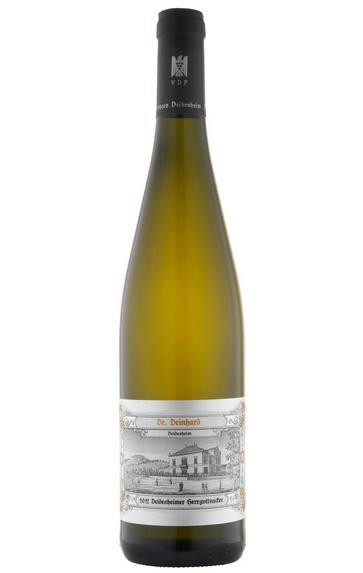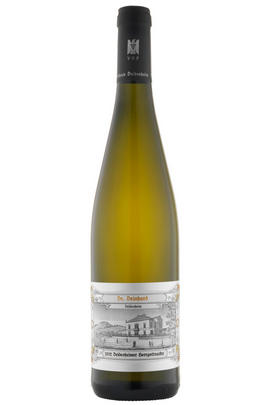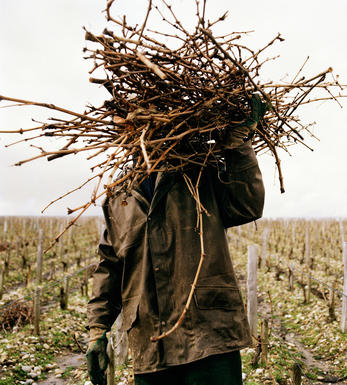
2012 Deidesheimer Herrgottsacker, 'SL', Riesling, Dry, Dr Deinhard, Pfalz

About this WINE

Dr.Deinhard/von Winning, Pfalz
Founded in 1849 by Dr.Deinhard, developed by his son-in-law Leopold von Winning in 1907, the estate was revived in 2007 by Achim Niederberger, together with the Bassermann-Jordan and von Buhl properties. Tragically Herr Niederberger died in 2013, with his wife Jana now continuing the great work.
Dr. Deinhard/von Winning estate draws on 42ha (of which 10ha are high density 9,000 plants/ha) of mainly Riesling vines among the villages of Ruppertsberg, Deidesheim, and Forst; villages that are central to the 23,000ha Pfalz region, Germany’s second warmest region (after Baden) whose 25 million yo sandstone, coral limestone and basalt soils lie on the east/southeast facing Haardt mountains, a northern extension of the Vosges, some 23km away from the river Rhine, looking across at the Black Forest; the perfect terroir then for fine dry Erste Lage and Grosses Gewächs Rieslings in particular.
Vinification takes place in a combination of barriques, big barrels and stainless-steel; the von Winning wines fermented with stalks (as per Knoll), benefitting from the phenols; free sulphur levels are a reasonable 40 mg/litre at bottling. Jana is supported by the team of: Kurt Rathgeber (head winemaker), Stephan Attmann, Andreas Hütwohl and Joachim Jaillet (vineyard manager). Their first vintage was the 2008.

Riesling
Riesling's twin peaks are its intense perfume and its piercing crisp acidity which it manages to retain even at high ripeness levels.
In Germany, Riesling constitutes around 20% of total plantings, yet it is responsible for all its greatest wines. It is planted widely on well-drained, south-facing slate-rich slopes, with the greatest wines coming from the best slopes in the best villages. It produces delicate, racy, nervy and stylish wines that cover a wide spectrum of flavours from steely and bone dry with beautifully scented fruits of apples,apricots, and sometimes peaches, through to the exotically sweet flavours of the great sweet wines.
It is also an important variety in Alsace where it produces slightly earthier, weightier and fuller wines than in Germany. The dry Rieslings can be austere and steely with hints of honey while the Vendages Tardives and Sélection de Grains Nobles are some of the greatest sweet wines in the world.
It is thanks to the New World that Riesling is enjoying a marked renaissance. In Australia the grape has developed a formidable reputation, delivering lime-sherbet fireworks amid the continental climate of Clare Valley an hour's drive north of Adelaide, while Barossa's Eden Valley is cooler still, producing restrained stony lime examples from the elevated granitic landscape; Tasmania is fast becoming their third Riesling mine, combining cool temperatures with high UV levels to deliver stunning prototypes.
New Zealand shares a similar climate, with Riesling and Pinot Gris neck to neck in their bid to be the next big thing after Sauvignon Blanc; perfectly suited is the South Island's Central Otago, with its granitic soils and continental climate, and the pebbly Brightwater area near Nelson. While Australia's Rieslings tend to be full-bodied & dry, the Kiwis are more inclined to be lighter bodied, more ethereal and sometimes off-dry; Alsace plays Mosel if you like.


Buying options
Add to wishlist
Description
More in keeping with Alsace due south perhaps, rather than the likes of the Mosel to the north-west, the Pfalz region is far from the Rhine so more continental; the perfect spot for dry Riesling then - this wine has 8.8 grams per litre of residual sugar, balanced by 7.4 grams per litre of total acidity. The village of Deidesheim, lying on the east facing slopes of the Haardt mountains on sandstone and limestone soils, seems to deliver refinement as well as substance to its dry Rieslings (compared to the peachiness of Forst Rieslings).
Herrgottsacker is one of the village's single vineyards, an 'Erste Lage' (Premier Cru), whose influence is visible via the wine's understated elegance; 'SL' stands for 'Spätlese', denoting its ripeness level. I love it's pink grapefruit purity and zing. It's very delicate, subdued even, preferring flowing persistence to (Forst's?) fireworks; erudite (in a word).
David Berry Green
wine at a glance
Delivery and quality guarantee